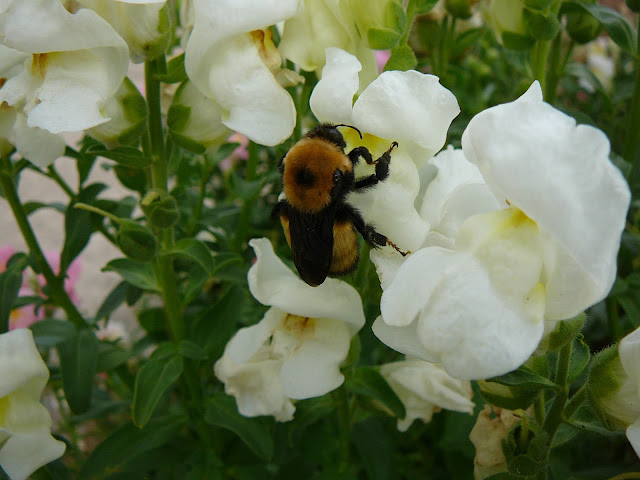Healthy working bumble bees.
They do so much good.
They are our pollinators.
Without them, we are pretty much finished.
No bees. No Vegetables.
So why is it that anyone, anyone, can buy horrible systemic insecticides on Amazon that can wipe out colonies of bees in one fell swoop? Who approves crap like "Safari" made by Bayer and Sumitomo? And who would apply this horrible poison to trees with the only warning "do not apply, if bees are visiting?" Bees don't visit here. They live here.
This is so horrible that it made news in Europe, where they have the good sense to ban this poison.
25,000 50,000 bumble bees wiped out in a Target parking lot over the weekend.
25,000 50,000.
From the Xerces website:
ODA has confirmed that the bee deaths are directly related to a pesticide application on the linden trees conducted last Saturday, June 15 to control aphids. The pesticide product Safari was used in that application. Safari, with its active ingredient dinotefuran, is part of a group of insecticides known as neonicotinoids. According to investigators, the insecticide was originally applied to control aphids, which secrete a sticky residue while feeding, and can be a nuisance to parked cars. Dinotefuran and other neonicotinoids are a relatively new group of insecticides that are long-lasting in plant tissues. Because of this, the scientists are now concerned about whether the trees will still be toxic next year when they flower again. Emergency measures to prevent further bee deaths were taken today by staff from the ODA, Xerces, and the City of Wilsonville. By the end of the day all of the trees will be covered with large nets to prevent bumble bees and other pollinators from reaching the flowers.
Scott Black, executive director of the Xerces Society, noted that the pesticide was applied to the tree while it was flowering, an action that violates the product’s instructions. “Beyond the fact that a pesticide was applied to plants while they were attracting large numbers of bees, in this case the pesticide was applied for purely cosmetic reasons. There was no threat to human health or the protection of farm crops that even factored into this decision.”
Europe has banned this poisonous crap, but Bayer, Monsanto, Sumitomo all have way too much power here in the U.S. to have horrible insecticides and herbicides banned. In fact, there are still some people who lament that DDT and Agent Orange are no longer available.
I was going to put the link to the article, but I am so damn mad, that I am putting the whole story from Oregonlive.com right here.
25,000 bumblebees killed, dropping from trees in Wilsonville; pesticide suspected | OregonLive.com
An estimated 25,000 bumblebees have been found dead in a Target parking lot in Wilsonville since Saturday, the largest known incident of bumblebee deaths in the United States, according to the
Xerces Society. Preliminary information suggests pesticides may be at fault.
The
Oregon Department of Agriculture received reports of bees and other insects falling out of 55 blooming European linden trees Monday from the Xerces Society for Invertebrate Conservation.
The bees were still dying on Wednesday. Yellow-faced bees fell from the trees, twitching on their backs or wandering in tight circles on the asphalt. Some honeybees and ladybugs were also found dead. A few dead bumblebees even clung to linden flowers, while hundreds littered the lot.
Dan Hilburn,
director of plant programs at the state Agriculture Department, surveyed the damage after an earlier assessment from pesticide experts.
"I've never encountered anything quite like it in 30 years in the business," he said Wednesday outside the Argyle Square Target.
Hilburn said initial findings indicate the trees were sprayed Saturday with an insecticide called
Safari. Tests to confirm what killed the bees will take at least two or three days, department officials said. The department of agriculture is also investigating other possible culprits, which may include other pesticides used in the surrounding area.
Safari is part of the neonicotinoid pesticide family. When it is sprayed on a plant, the leaves, flowers and nectar become toxic to almost all insects. The product's label on the distributor's website warns it is "highly toxic" to bees and tells applicators not to apply it "if bees are visiting the area."
"Bumblebees are the single most important natural pollinator in Oregon," said Mace Vaughan, pollinator program director for Xerces.
They play a crucial role in pollinating berries, flowers and other plants. The decline of the honeybee, whose populations have been decimated by
Colony Collapse Disorder, has received much attention, but bumblebee populations are decreasing as well.
Elliot Associates Inc., the company that rents and manages the Argyle Square land, did not respond to multiple calls by The Oregonian. The landscapers that care for the grounds couldn't be reached for comment.
The Agriculture Department is working with the Xerces Society to help mitigate any further insect deaths at Argyle Square. As precautionary moves, they are considering either putting up netting around the trees, stripping off flowers and leaves or finding non-toxic repellents to keep bees and insects from eating the leaves or nectar.
Dale Mitchell, pesticide compliance program manager for the state agriculture department, said if test show pesticide is the culprit, the department will assess if the company responsible violated any state or federal laws, and if so, the severity of those violations. Fines for pesticide regulation infractions can range from $1000 to $10,000.
The bumblebee deaths marked an inauspicious start to National Pollinator Week, which runs through June 23.
-- Elizabeth Case
To see the pictures: http://www.oregonlive.com/environment/index.ssf/2013/06/25000_bubblebees_killed_droppi.html#/0
When does it stop?















